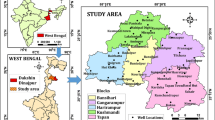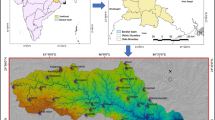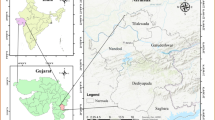Abstract
Delineation of groundwater potential zones based on the scientific technique is essential for the management of groundwater resource and landuse planning. In the present study groundwater potential map has been prepared using the analytical hierarchical process in GIS and remote sensing environment. The AHP method has used to determine the weights of various thematic layers. With the help of linear combination method these weights of thematic layers are added to identify the different groundwater potential zones in the study area, namely ‘very poor’, ‘poor’, ‘fair’, ‘good’ and ‘excellent’. However, the area having very poor, poor, fair, good and excellent groundwater potential is about 34.474, 75.216, 81.484, 81.484 and 40.742 km2 respectively. The groundwater potential zone map has finally validated using the ROC and trend surface analysis technique incorporating the well yield data of 25 pumping wells and groundwater depth data. ROC result shows the area under curve for the AHP model is 0.7776 which corresponds to the prediction accuracy of 77.76% and linear regression coefficient of groundwater depth and its corresponding groundwater potential index is 0.548. Taking together, it could be argued that the AHP model has performed good prediction accuracy.






Similar content being viewed by others
References
Vaux, H. (2011). Groundwater under stress: The importance of management. Environmental Earth Sciences, 62, 19–23.
Mukherjee, P., Singh, C. K., & Mukherjee, S. (2012). Delineation of groundwater potential zones in arid region of India—A remote sensing and GIS approach. Water Resources Management, 26, 2643–2672.
Jha, M. K., Chowdary, V. M., & Chowdhury, A. (2010). Groundwater assessment in Salboni Block, West Bengal (India) using remote sensing, geographical information system and multi-criteria decision analysis techniques. Hydrogeology Journal, 18, 1713–1728. doi:10.1007/s10040-010-0631-z.
Israil, M., Al-hadithi, M., & Singhal, D. C. (2006). Application of a resistivity survey and geographical information system (GIS) analysis for hydrogeological zoning of a piedmont area, Himalayan foothill region, India. Hydrogeology Journal, 14, 753–759. doi:10.1007/s10040-005-0483-0.
Jha, M. K., Chowdary, V. M., & Chowdhury, A. (2010). Groundwater assessment in Salboni Block, West Bengal (India) using remote sensing, geographical information system and multi-criteria decision analysis techniques. Hydrogeology Journal, 18, 1713–1728. doi:10.1007/s10040-010-0631-z.
Brunner, P., Bauer, P., Eugster, M., & Kinzelbach, W. (2004). Using remote sensing to regionalize local rainfall recharge rates obtained from the chloride method. Journal of Hydrology, 294(4), 241–250.
Bandyopadhyay, S., Srivastava, S. K., Jha, M. K., Hegde, V. S., & Jayaraman, V. (2007). Harnessing earth observation (EO) capabilities in hydrogeology: An Indian perspective. Hydrogeology Journal, 15(1), 155–158.
Jha, M. K., & Chowdary, V. M. (2007). Challenges of using remote sensing and GIS in developing nations. Hydrogeology Journal, 15(1), 197–200.
Dar, I. A., Sankar, K., & Dar, M. A. (2010). Remote sensing technology and geographic information system modeling: An integrated approach towards the mapping of groundwater potential zones in Hardrock terrain, Mamundiyar basin. Journal of Hydrology, 394, 285–295.
Saaty, T. L. (1980). The analytic hierarchy process (pp. 513–516). New York, NY: McGraw-Hill.
Yang, C. L., Chuang. S. P., Huang, R. H., & Tai, C. C. (2008). Location selection based on AHP/ANP approach. In International conference on industrial engineering and engineering management, Singapore (pp. 1148–1153). IEEE.
Saaty, T. L. (1996). Decision making with dependence and feedback, the analytic network process. Pittsburgh: RWS Publications.
Dagdeviren, M., & Yüksel, İ. (2007). Using the analytic network process (ANP) in a SWOT analysis—A case study for a textile firm. Information Sciences, 177(16), 3364–3382.
Magesh, N. S., Chandrasekar, N., & Soundranayagam, J. P. (2012). Delineation of groundwater potential zones in Theni district, Tamil Nadu, using remote sensing. GIS and MIF techniques. Geoscience Frontiers, 3(2), 189–196.
Shekhar, S., & Pandey, A. C. (2015). Delineation of groundwater potential zone in hard rock terrain of India using remote sensing, geographical information system (GIS) and analytic hierarchy process (AHP) techniques. Geocarto International, 30(4), 402–421. doi:10.1080/10106049.2014.894584.
Adiat, K. A. N., Nawawi, M. N. M., & Abdullah, K. (2012). Assessing the accuracy of GIS-based elementary multi criteria decision analysis as a spatial prediction tool—A case of predicting potential zones of sustainable groundwater resources. Journal of Hydrology, 440, 75–89.
Nampak, H., Pradhan, B., & Manap, M. A. (2014). Application of GIS based data driven evidential belief function model to predict groundwater potential zonation. Journal of Hydrology, 513, 283–300.
Pourghasemi, H. R., Moradi, H. R., & FatemiAghda, S. M. (2013). Landslide susceptibility mapping by binary logistic regression, analytical hierarchy process, and statistical index models and assessment of their performances. Natural Hazards, 69, 749–779.
Moore, I. D., Grayson, R. B., & Ladson, A. R. (1991). Digital terrain modeling: A review of hydrological, geomorphological and biological applications. Hydrological Processes, 5, 3–30.
Prasad, R. K., Mondal, N. C., Banerjee, P., Nandakumar, M. V., & Singh, V. S. (2008). Deciphering potential groundwater zone in hard rock through the application of GIS. Environmental Geology, 55(3), 467–475.
Sree Devi, P. D. S., Srinivasulu, S., & Raju, K. K. (2001). Hydrogeomorphological and groundwater prospects of the Pageru river basin by using remote sensing data. Environmental Geology, 40, 1088–1094. doi:10.1007/s002540100295.
Pradhan, B., Singh, R. P., & Buchroithner, M. F. (2006). Estimation of stress and its use in evaluation of landslide prone regions using remote sensing data. Advances in Space Research, 37, 698–709.
Malczewski, J. (1999). GIS and multicriteria decision analysis. New York: Wiley.
Rahmati, O., Nazari, S. A., Mahmoodi, N., & Mahdavi, M. (2014). Assessment of the contribution of N-fertilizers to nitrate pollution of groundwater in western Iran (case study: Ghorveh–Dehgelan Aquifer). Water Quality, Exposure, and Health, 7(2), 143–151. doi:10.1007/s12403-014-0135-5.
Chung, J. F., & Fabbri, A. G. (2003). Validation of spatial prediction models for landslide hazard mapping. Natural Hazards, 30(3), 451–472.
Sarkar, K., & Sarkar, I. (2015). Introduction to quantitative analysis in geography and geology: An approach to numerical data analysis and description (p. 632p). Kolkata: Progatishil Prakashak.
Ozdemir, A., & Altural, T. (2013). A comparative study of frequency ratio, weights of evidence and logistic regression methods for landslide susceptibility mapping: Sultan Mountains, SW Turkey. Journal of Asian Earth Sciences, 64, 180–197.
Akgün, A., Dag, S., & Bulut, F. (2008). Landslide susceptibility mapping for a landslide prone area (Findikli, NE of Turkey) by likelihood-frequency ratio and weighted linear combination models. Environmental Geology, 54, 1127–1143.
Egan, J. P. (1975). Signal detection theory and ROC analysis (pp. 266–268). New York: Academic.
Negnevitsky, M. (2002). Artificial intelligence: A guide to intelligent systems. Harlow: Pearson.
Mathew, J., Jha, V. K., & Rawat, G. S. (2009). Landslide susceptibility zonation mapping and its validation in part of Garhwal Lesser Himalaya, India, using binary logistic regression analysis and receiver operating characteristic curve method. Landslide, 6, 17–26.
Cervi, F., Berti, M., Borgatti, L., Ronchetti, F., Manenti, F., & Corsini, A. (2010). Comparing predictive capability of statistical and deterministic methods for landslide susceptibility mapping: A case study in the northern Apennines (Reggio Emilia Province, Italy). Landslide, 7(4), 433–444.
Yesilnacar, E. K. (2005). The application of computational intelligence to landslide susceptibility mapping in Turkey. PhD Thesis, University of Melbourne, Australia, 423 pp.
Pourghasemi, H. R., Pradhan, B., & Gokceoglu, C. (2012). Application of fuzzy logic and analytical hierarchy process (AHP) to landslide susceptibility mapping at Haraz watershed, Iran. Natural Hazards, 63(2), 965–996.
Mohammady, M., Pourghasemi, H. R., & Pradhan, B. (2012). Landslide susceptibility mapping at Golestan Province, Iran: A comparison between frequency ratio, Dempster–Shafer, and weights-of-evidence models. Journal of Asian Earth Sciences, 61, 221–236.
Pradhan, B. (2013). A comparative study on the predictive ability of the decision tree, support vector machine and neuro-fuzzy models in landslide susceptibility mapping using GIS. Computers & Geosciences, 51, 350–365.
Acknowledgements
The author would like to thanks to Central Ground Water Board Ministry of Water Resources Government of India for providing required information regarding groundwater depth. Additionally, author would like to acknowledge all of the agencies and individuals specially, Survey of India, Geological Survey of India and USGS for obtaining the maps required for the study.
Author information
Authors and Affiliations
Corresponding author
Electronic supplementary material
Below is the link to the electronic supplementary material.
Rights and permissions
About this article
Cite this article
Saha, S. Groundwater potential mapping using analytical hierarchical process: a study on Md. Bazar Block of Birbhum District, West Bengal. Spat. Inf. Res. 25, 615–626 (2017). https://doi.org/10.1007/s41324-017-0127-1
Received:
Revised:
Accepted:
Published:
Issue Date:
DOI: https://doi.org/10.1007/s41324-017-0127-1




